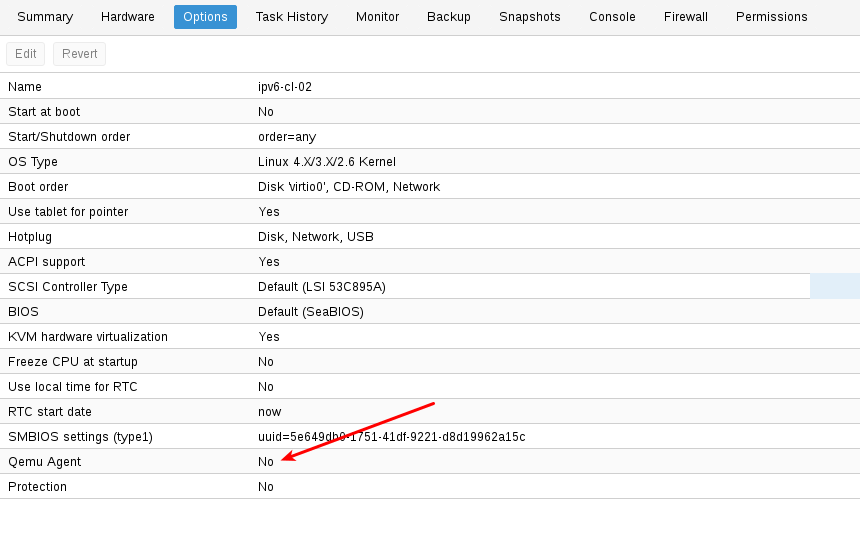Proxmox Windows Agent
I have a Windows 10 VM set up on my Ubuntu 16.04.3 LTS laptop. Overall the experience has been good -- even to the point of having multiple displays configured for the guest.
I started by installed the QEMU Guest Agent found here:
Data ontap version. Starting with ONTAP Select 9.4 & ONTAP Deploy 2.8 software RAID supported with no requirements for 3rd party HW RAID equipment for KVM and starting with ONTAP 9.5 with ESXi. NetApp ONTAP SelectONTAP Select can run on VMware ESXi and Linux KVM. ONTAP Select and Cloud Volumes ONTAP provide high availability, deduplication, resiliency, data recovery, robust snapshots which can be integrated with application backup (application consistent snapshots) and nearly all ONTAP functionality but with few exceptions. Software-defined versions of ONTAP have nearly all the functionality except for Hardware-centric features like ifgroups, service processor, physical disk drives with encryption, MetroCluster over FCP, Fiber Channel protocol.ONTAP Select. ONTAP Select leveraged RAID data protection on SSD and HDD drive level with underlying DAS, SAN or vSAN storage systems.
In Proxmox VE, the qemu-guest-agent is used for mainly two things: To properly shutdown the guest, instead of relying on ACPI commands or windows policies; To freeze the guest file system when making a backup (on windows, use the volume shadow copy service VSS). So: installing qemu-agent.
- Proxmox Virtual Environment. Proxmox VE is a complete open-source platform for enterprise virtualization. With the built-in web interface you can easily manage VMs and containers, software-defined storage and networking, high-availability clustering, and multiple out-of-the-box tools on a single solution.
- Mar 01, 2019 70+ channels, more of your favorite shows, & unlimited DVR storage space all in one great price.
- When running Windows VMs on Proxmox and you want to make snapshot backups you really want to run the qemu-agent inside the Windows VMs. First of all you really want snapshot mode backups as of all backup modes they have the least downtime.
- So yeah, this one’s on me. This should be added to the Windows 10 on Proxmox guide, but I figured a post on it’s own wouldn’t hurt. So what is the QEMU Agent? Straight from the libvirt webs.
This got me fairly far, but things like mouse performance were abysmal.
Eventually came across this wonderful package, and it made everything work much better:
Things are CONSIDERABLY BETTER with this agent, including dynamic screen resize, clipboard between guest/host, etc.
As it stands right now, I have both installed. However, it looked like the 'spice-guest-tools' installed most of the same drivers that I did manually with the QEMU guest ISO.
Is it safe to remove the QEMU Guest Agent? Will I lose the ability to send commands to the VM via virsh if I do? Any explicit problems with leaving both intact (it all seems to be working fine right now)?
Ellman captures the wit, creativity, and charm of the psychologically and sexually complicated writer, as well as the darker aspects of his personality and life. Ellmann dedicated two decades to the research and writing of this biography, resulting in a complex and richly detailed portrait of Oscar Wilde. James joyce richard ellmann pdf.
Looking through the manual didn't seem to give a ton of guidance:
At best, it was wishy washy, depending on how you installed other drivers.
Can the 'spice-guest-tools' installation stand alone on a Windows guest, or do I need both agents for full functionality?

1 Answer
The QEMU Guest Agent (qemu-ga) and the SPICE agent are both needed for different purposes.
'QEMU Guest Agent' is one specific component of the 'virtio-win' set of drivers offered by RedHat. For a list of all components, check https://docs.fedoraproject.org/quick-docs/en-US/creating-windows-virtual-machines-using-virtio-drivers.html#virtio-win-iso-contents. These components are not installed all at once as part of a package; instead, the user is expected to manually install what is needed for his particular case.
This is different from the SPICE agent: according to the download page you linked (https://www.spice-space.org/download.html) and also the source repository (https://gitlab.com/spice/spice-nsis), this one includes the qxl video driver and the vioserial (VirtIO serial driver). The latter is a dependency, as the agent communicates with the host through a VirtIO serial channel. The former may be just convenience, or may be needed for automatic resolution switching - I don't know for sure.
So, even though the 'SPICE guest tools' installer for Windows includes some of the virtualization drivers for Windows offered by RedHat, the qemu guest agent itself is not part of the package, and is also not related.
Proxmox Windows Server 2016 Guest Agent
Once installed, it runs as a Windows service (you can find it in services.msc) and should start automatically. It enables better integration between guest and the hypervisor through a virtio-serial channel (like SPICE) but for management purposes.
To understand how, check these references from the Red Hat Virtualization Deployment and Administration Guide:
(I used to think that qemu-ga was a requirement for the balloon driver to work; looks like I was wrong, though).